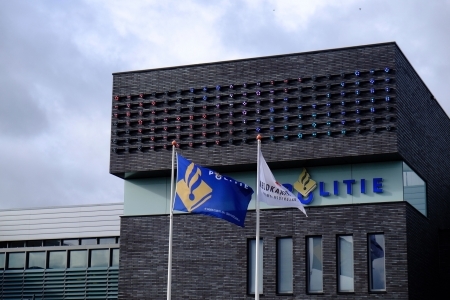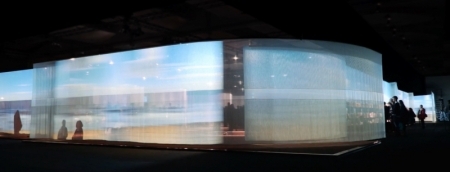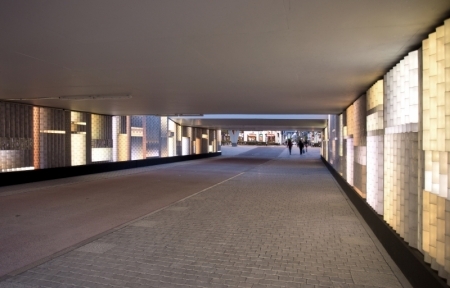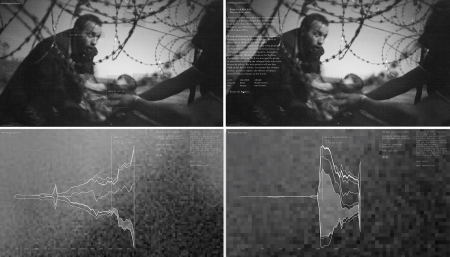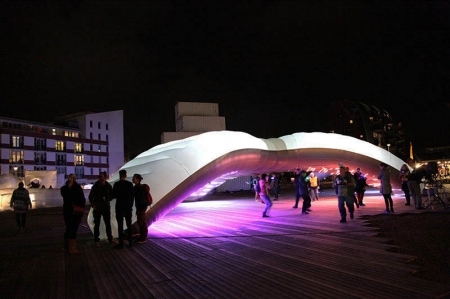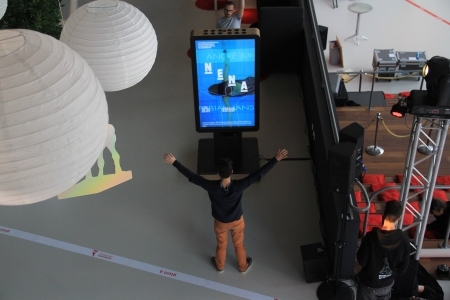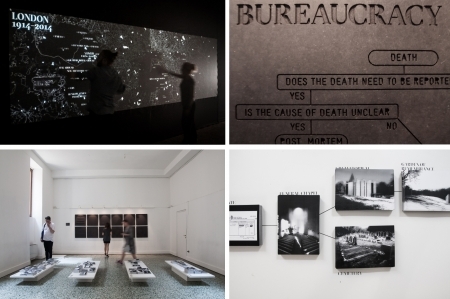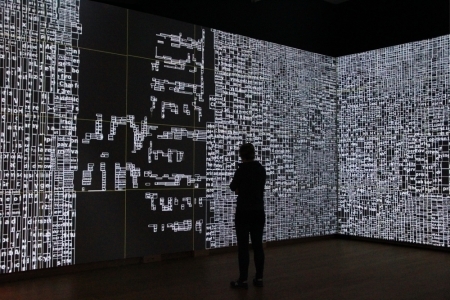-
info
The 2017 edition of the Museum of the Future proposed visions for the future in the United Arab Emirates, facing climate change in the year 2050. In this perspective the Museum of the Future functioned as a scientific and technological incubator in setting strategies and possible solutions to avoid the extinction threshold by treating water, food and shelter as opportunities. The exhibition took place during the 5th annual World Government Summit in Dubai. The initiative held by HH Sheikh Mohammed bin Rashid Al Maktoum marked the second year LUST has designed the visual identity. The theme Climate Change Reimagined has been treated through three sections around water supply, food security and self-sufficient cities: Bio-Desalination Plant as a UAE based facility designed to filter locally saltwater into clean drinking water combining the genes of jellyfish with mangrove roots. In this first section, attendees were welcomed onto a projected viewing deck of an offshore bio-desalination plant in Dubai. 360 ° video projections took guests on an immersive journey underwater to see how the facility provides a local means of filtering saltwater into clean drinking water based on natural processes. This freshwater factory they visited is the result of combining the genes of a jellyfish, a highly absorptive natural material, with mangrove roots, one of nature’s best desalinators. In this future scenario, Dubai became pioneers in biomimicry and exports these bio-desalination plants across the world, making fresh water accessible to everyone. AutoFarm as a fully automated robotic urban farm that can grow fresh food indoors for entire neighbourhood warehouse. The lush space allowed guests to witness plant seeds being printed and plants, fish and insects being grown with incredible efficiency. Guests even enjoyed tasting samples created by the Food Bot: a machine that harvests produce the moment it is ripe and turns it into nutritious food items. City Kit Sales Center as a self-building infrastructure solution using biotechnology and robotics to build pattern of generative self-sufficient cities. Research suggests that over 375 million people will be displaced because of rising sea levels if global temperatures continue to rise. The “City Kit” Sales Centre showed attendees these self-building infrastructures that will assist and remedy this future massive displacement. Summit attendees were asked to test out the Kit and see it in action using an interactive demo. The demo showed deployment from the sky and within seconds the Kit unfolding itself into a skeleton of a house. After evaluating local surroundings, it transforms local resources into building materials. As more Kits are dropped, they connect together to develop a fluid urban network that grows organically.
-
info
The monitoring station Drachten opened a new building on the edge of the city of Drachten, Friesland, NL. The building, where also the police is housed, is a relatively non-descript building, one can not see what is all happening in the building. In cooperation with Karel Martens we designed a LED installation that displays the number of emergency calls per day to 1-1-2, and other messages related to the function of the building. The installation is on 24 hrs a day. The pattern that the lights consists of is not a regular one, but different for each unit. Cooperation with Karel Martens
-
info
Flanders and the Netherlands are the joint Guest of Honour at the 68th Frankfurt Book Fair from 19 to 23 October 2016. They not only share a common language – Dutch – but can also look back on a common history in art, culture and literature. True to the motto Dit is wat we delen /This is what we share, there will naturally be novels, nonfiction and poetry, but also young writers, new genres and new formats from the bookmaking crafts, the creative industry and other currents of artistic expression. The pavilion was designed by The Cloud Collective, with a big open space to provide some air in the busy Buchmesse. LUST designed a 60 meter long Horizon panorama, in which in 30 minutes, one whole day can be seen, from sunrise to sunset, creating a new landscape in time. The Horizon, normally a line that divides water or earth and the sky, is now an area. This extended line is emphasised in the transparent zone of the screens as well as in the architecture.
-
info
Kunnen technologie, sociale veiligheid en een atmosfeer elkaar versterken in een architectonisch ontwerp? De Willem II passage is een nieuwe verbinding die de binnenstad van Tilburg verbindt met het ontwikkelgebied De Spoorzone. In een traject van ontwerpen, bouwen, testen en aanpassen ontwikkelde The Cloud Collective een verfijnde, maar robuuste glazen baksteengevel. Het materiaalgebruik van gevel en maaiveld, de ritmiek en de compositie verwijzen op een hedendaagse manier naar de architectuur van de omgeving. De tunnel bestaat uit hardware (vloeren, plafonds en gevels) en interactieve software. In samenwerking met Philips Lighting werd sociaal veilige verlichting ontwikkeld. In iedere glazen steen zijn LEDs geïntegreerd, die op pixelniveau aanstuurbaar zijn naar kleur en intensiteit. De lichtpatronen reageren op voorbijgangers en accentueren de tactiliteit van de passage. De programmering van de lichtpatronen past zich aan het tijdstip, het jaargetijde, het weer of voor speciale evenementen. Het lichtontwerp benadrukt de architectuur, en behandelt de wanden perse niet als een scherm. Het lichtontwerp benadrukt de architectuur, en behandelt de wanden perse niet als een scherm. De technologie speelt geen hoofdrol maar doet wat het moet doen. De interactiviteit opereert op de achtergrond en voegt zich naar de architectuur. Zo wordt de passage een vanzelfsprekend onderdeel van het openbare netwerk in de stad en wordt vermeden dat de passage verouderd door het verouderen van zijn technologie. De Willem-II-passage is een belangrijke openbare verbinding. Het totale ontwerp zet daarom in op de publieke betekenis en culturele houdbaarheid. Het geheel moet een blijvende indruk achter laten en na twintig of dertig jaar net zo interessant zijn als vlak na oplevering. Vertrouwd, vanzelfsprekend en robuust, maar vernieuwend, rijk en geraffineerd. Built to Last.
-
info
A baby is handed through a hole in a razor wire barrier, to a Syrian refugee who has already managed to cross the border from Serbia into Hungary, near Röszke, Hungary, on 28 August 2015. Photographs give us information and feed our emotions. The Bigger Picture invites you to explore the deeper meaning of what you might not see at a first glance. What is the story behind the image? What else is there to know? What is the bigger picture? The Bigger Picture is a collaboration between the Centre for Innovation (Leiden University) and the World Press Photo Foundation. The initiative brings together the worlds of photography, data analytics and storytelling in a compelling visual platform, to take you beyond the frame. Starting with World Press Photo’s award-winning photographs, users are drawn into a new type of visual analytics. With each click, we expand the way you can look at news, events, and issues. Warren Richardson is a freelance photojournalist currently working in Eastern Europe. Born in Australia in 1968, he is a self-taught photographer who undertakes long-term projects dealing with human and environmental issues, as well as assignments for newspapers, magazines and companies. While working on the Serbian-Hungarian border in 2015, he was one of a group of journalists covering the refugee crisis who were beaten by police. His next project will see him walk to the Arctic Circle, to continue his refugee stories, and then explore the effects of human-induced climate change on the world.
-
info
The digital world impacts the physical tangible world. But how and in what way? How do social networks and collected data influence the physical city? Rezone builds upon the ‘interconnectedness’ of the online and offline world and translates this in a surprising way which can be experienced with all the senses through a peculiar pavilion, Little Babylon. For Shine festival (7-17 May 2015) we developed an interactive inflatable pavilion, Little Babylon. The pavilion shows the sentiment of the city. How does ‘s-Hertogenbosch feel today? It scans the streaming of online networks and social media and through this content combined with the interaction of the audience on location the pavilion changes in shape, image and sound, thus expressing the immediate feeling of the city.
-
info
Film by definition is linear, the narrative unfolds itself over time. Camera Postura allows for a more non-linear way of experiencing movies, reacting dynamically to the body language of the viewer. Camera Postura attempts to match your body language to scenes in the movie with similar poses. These scenes are then augmented with additional information, such as actor names, locations, tweets and film reviews of the movie. Imagine searching for similar films scenes as Rocky's victory dance on top of the steps just by raising your arms. Each pose results in different matched scenes creating unique film posters at each visit. The installation is presented during the Netherlands Film Festival (24/9-3/10 2014) and allows the visitors to translate their gestures into scenes from 20 of the festival's most popular films — including the opening film Bloedlink — creating a unique poster at each pose. While films tend to be linear, databases are more unpredictable. Unforeseen associations emerge as one navigates them, recalling the action of strolling across some archive with its associated lot of discoveries. Yet, databases precisely lack this embodied, 'strolling' dimension. Each path within the database is amplified by cinematic expansions of color values and acoustic enhancements that trigger nothing but a fiction of mastery — fiction that obnubilates the actual experience of the archive. With Camera Postura, the point therefore became to explore this cinematic quality of the database, while pushing film away from its linear self. By transforming the 'filmbase' into a mirror that is responsive to the body as a whole, the experience of the films and the one of their selection are folded together. The database is reincarnated — becoming endowed with the archive and cinema's bodily dimension — while films are endued with the archive's collage-like structure — jumping across all scenes and shots alike. A posture initiates a search request, a movement a transition between two films and information then reveals itself insofar as it is given a body — the user's.
-
info
Death in Venice is a research project and interactive exhibition exploring the relationship between modern architecture and death over the last century. The first iteration of the exhibition was held in Venice in June 2014. The development of architecture related to death and dying has been, over the past decades, as vivid and significant as the development of other modern ideas that shaped the contemporary city. Nevertheless, it is rarely foregrounded in the architectural history of the 20th century. Death in Venice shows the changing landscape of death in modern Britain, the site of early developments in modern western cremation and the modern hospice movement which helped to shape a broader Western context. It examines the changes which have taken place in Great Britain over the last 100 years, taking them as a point of departure to reflect on the current shape of death and the architecture which offers space for it. The exhibition is split into three rooms, each offering a different way of interacting with the content. The first room presents an interactive map of London, where the typical content is inverted: common landmarks are hidden while hospitals, hospices, crematoria and cemeteries are highlighted. Labels and captions can be uncovered by the user but fade away again with time. The second room approaches the subject through an emotional experience of sound and space. The room is periodically filled with fog, so that projected light patterns create an intangible three-dimensional structure. These generated patterns abide by the rules of a custom cellular automata, which focuses on spatial relationships and biological processes. Sound serves as an additional metaphor for death: sensory and pervasive, yet invisible. Each individual visitor is assigned a unique sound as they enter, while the projection creates a corresponding blank space surrounding the visitor's body within the fog. Both the sound and the projected patterns respond to the movements of each visitor, building a generative musical and spatial composition as visitors move through the space. The third room presents the research content in a focused, analytical way. Large-scale flowcharts outline the common scenarios surrounding death during the four sample years, while stacks of postcards with archival photography, statistics and floorplans illustrate the changes in architecture, social attitudes and rituals over time. These are accompanied by CNC-milled infographic panels that show the social and cultural shifts throughout the century. As with the first room, the content of these panels is "hidden" but can be revealed by rubbing them with charcoal.
-
info
Pages Magazine began in February 2004; a bilingual -Farsi/English- periodical pursuing an exchange between Iranian and international authors and artists with critical views on art, culture, urbanism and social issues. The central idea is to offer both languages equally without showing hierarchical preference (ie in typography, layout etc). So the magazine has 2 front covers depending on if you read the magazine as a Farsi or English reader. The english pages are always printed on the right side and the Farsi on the left. The content runs parallel to each other to avoid repeating images. In other words, the Farsi contents are the mirror (or reversed) of the English, and vice versa. In order to emphasize the continuing aspect of the magazine as a work-in-progress the pages are progressively page-numbered continuing further from each issue to the next. The first issue ends on page 32. The second issue begins with page 33, etc. Pages Magazine, No. 9 was published in October 2013.
-
info
Voor de tentoonstelling Type/Dynamics heeft LUST een nieuwe interactieve installatie gemaakt, in opdracht van het Stedelijk Museum Amsterdam, naar aanleiding van het boek dat Frederike Huygen over de ontwerper en typograaf Jurriaan Schrofer (1926-1990) heeft geschreven. Het is een werk dat reageert, speelt met, aansluit op, en commentaar levert op het werk van Schrofer en het in een hedendaags licht stelt. Het project stelt zich ten doel om de ontwerpgeschiedenis te actualiseren en te revitaliseren. Het oeuvre van Jurriaan Schrofer bestaat voornamelijk uit drukwerk dat “met de hand” ontworpen is. Maar al vanaf de jaren zestig reageerde hij op nieuwe technieken als offset om “bewegende” typografie te bereiken. In al zijn werk is eigenlijk dynamiek een rode draad. Vanaf de jaren zeventig exploreerde hij als een onderzoekend vormgever patronen en structuren, mede-geïnspireerd op de ‘Op art’. Vreemde perspectieven, dieptewerking en lettertekens heeft hij met grote bezetenheid onderzocht. Hoewel het werk van LUST en het werk van Jurriaan Schrofer, zeker inhoudelijk, behoorlijk verschillend is, heeft het ook een aantal overeenkomsten. Typografie speelt in het werk van beiden een heel belangrijke rol, en dan vooral waar de typografie tekst en beeld tegelijkertijd is. Verder gebruiken beiden ook regelmatig kleine elementen of modules die bij elkaar een groter geheel vormen, zoals patronen en structuren. In het Stedelijk Museum beslaat de tentoonstelling twee vrijwel identieke ruimtes die zich conceptueel spiegelen: In de eerste ruimte zijn de muren behangen met afbeeldingen van werk van Schrofer. Tussen deze reproducties worden ook originelen getoond, in een aantal vitrines aan de muur. Ook zijn er twee schermen waar bezoekers werken van Schrofer interactief kunnen bekijken met een nadruk op de handmatige productie en het schetsproces. De tweede ruimte is een vrije interpretatie van het werk van Schrofer door LUST. Deze ruimte is geheel gevuld met continu bewegende en dynamische typografie. De installatie is een visualisatie van het gegeven dat we tegenwoordig overal informatie om ons heen hebben, op elk moment en op elke locatie, wat ook nog eens op elk moment oproepbaar is. De ruimte zoekt real-time naar nieuws met een specifieke locatie, zoals "Ground Zero", "Reichstag" of "Tiananmenplein". Plekken die er op dit moment toe doen. Als bezoeker sta je letterlijk op die locatie, geheel omgeven door al het nieuws dat op dit moment over die plek te vinden is. In plaats van een fotografische representatie is de plek puur typografisch verbeeld aan de hand van allerlei nieuwsberichten die over die plek gaan, achtergrondinformatie over die plek, de geschiedenis van die plek, etc.. De bezoeker wordt door middel van 3D sensoren gevolgd en de projecties reageren op de positie van de bezoeker, de hoeveelheid bezoekers, hoe bezoekers zich door de ruimte bewegen en hun afstand tot de muren. Als bezoeker kan je meer te weten komen over een bepaald onderwerp, door naar iets wat je interessant lijkt toe te lopen. Hierdoor wordt het typografisch grid groter en is het deel waar je voor staat duidelijker te lezend en wanneer je nog dichter naar de muur loopt, toont het systeem meer informatie rond het onderwerp waar je op "ingezoomd" bent. Het inzoomen is geen letterlijke inzoom, maar een "schalen" van informatie. De tekst wordt niet veel groter, maar je kan de teksten als bezoeker beter lezen. Het typografisch grid deelt zich in meer cellen die weer gevuld worden met nieuwe informatie. In de installatie kan de bezoeker tot drie lagen diep informatie tot zich nemen. De ervaring is als een soort 'Aleph' uit het gelijknamige boek van Jorge Luis Borges, een punt waar je tegelijkertijd alles wat er op de wereld in heden en verleden is gebeurt tegelijkertijd ziet. Dit is zo veel en overweldigend dat je eigenlijk niets meer ziet.
Curriculum vitae
Opleidingen
-
1993 - 1995Graphic Design Arnhem, ARTEZ, Academie Beeldende Kunst en Vormgeving Diploma behaald
-
1991 - 1993Graphic Design Utrecht, HKU faculteit Kunst en Vormgeving
-
1987 - 1990Psychology (major), Fine Art (minor) University of California, Irvine
tentoonstellingen
-
2016Hyperlocator, What’s next, Future Tomorrow, 38CC Delft, July-August 2016 zie beeldmateriaal Solo
-
2016Cartographies of Rest, interactive installation at Mile End Art Pavilion in London, October 2016 zie beeldmateriaal Solo
-
2014Camera Postura, interactive cinematic installation for Dutch Film Festival, September 2014 zie beeldmateriaal Solo
-
2014Interactype at TypoMad, Exhibition of Type/Dynamics Dance Movie, Madrid, November 2014 zie beeldmateriaal Groep
-
2014Dutch Design Awards, Exhibition of Type/Dynamics Dance Movie, Eindhoven, October 2014 zie beeldmateriaal Groep
-
2014All possible futures, Group exhibition, SomArts gallery, San Francisco, jan-feb 2014 zie beeldmateriaal Groep
-
2013Type/Dynamics, Stedelijk Museum Amsterdam zie beeldmateriaal Solo
projecten
-
2016
Grafill, Stavanger, Norway, January 2016 Stavanger Symposium
-
2016
Open Set, memories of the Future, Leeum Samsung Museum of Art, Seoul, South Korea, February 2016 Leeum Samsung Museum of Art Workshop
-
2015
Digital Crunch symposium, Stockholm, May 2015 Symposium Stockholm Symposium
-
2014
Lecture and workshop at ISIA, Urbino, Italy, June 2014 ISIA Lecture & Workshop
-
2013
Graphic Design: Now in Production lecture at Kendall College of Art and Design in Grand Rapids, MI., January, 2013 Kendall College of Art and Design / Walker Art Center Symposium
Internationale uitwisselingen / Artist-in-residencies
-
2007Design Fellowship, Leeds Metropolitan University, Leeds, UK
publicaties
-
2017DUDE: Dutch Designers Magazine BNO
-
2016Designing in Liquid Times: Generative Graphic Design in an Age of Uncertainty, Marlies Peeters, Parsons School of Design, Plot(s), 2016 Parsons School of Design
-
2016Walker Art Center, Hippie Modernism, 2016 Walker Art Center
-
2015Interview by Robert Urquhart on Grafik.net, Dutch Masters, 2015 Grafik.net
-
2015PencilCase #3, Environmental Graphic and Art magazine, March 2015 Environmental Graphic and Art magazine
Prijzen en stipendia
-
2017iFF Award Willem II passage Tilburg, 2017 iFF Award
-
2017BNO Piet Zwart Oeuvreprijs 2017 BNO
-
2014Nominated 'Dutch Design Award' for Type/Dynamics exhibition, 2014 Dutch Design Award
-
2012Nominated 'Dutch Design Award' for PolyArc, 2012 Dutch Design Award
-
2008Interactive Media for overview exhibition 100 Years Graphic Design, Graphic Design Museum Breda Dutch Design award, Eindhoven
-
2007Best Dutch Book Designs 2007, Yearly Exhibition of Best Dutch Book Designs, Yearly Exhibition of Best Dutch Book Designs, Pages
artistieke nevenactiviteiten
-
2012 - --hoofd afdeling Graphic Design Arnhem, ArtEZ University of the Arts
-
2002 - --docent Graphic Design and Typography, ArtEZ University of the Arts
